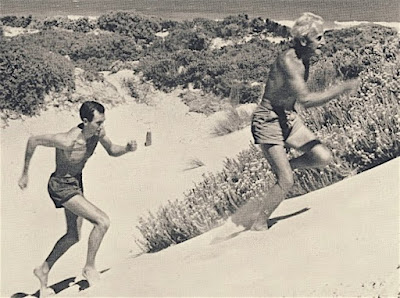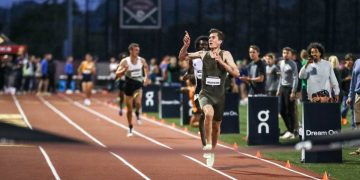I learned about Mike Spino, I believe, in 1975, in an article in Runners’ World. I was fascinated with his thoughts on mindful running and his desire to help runners enjoy their running at a higher level. His visualization techniques are used in some form or another by most of the elite and professional athletes, regardless of sports. Mike Spino has been influenced by his studies with the late Percy Cerutty and the late Mihaly Igloi. I believe Mike trained under both.
Enjoy this first article from Mike Spino for RunBlogRun!

Herb Elliott (1960 Olympic 1,500m champ) chasing his coach, Percy Cerrutty, photo Herald Newspaper / Australia
Visualization and Guided Imagery in Running
By Mike Spino, Ph.D.
Visualization and Guided Imagery in running is a tool to make your running more delightful and full of insightful thoughts and pleasant memories. Contained in this article is a time-tested procedure that I have used in my 50 years of mind/body running coaching. My name is Mike Spino, Ph.D., and many consider me the father of mindful running. I trained with Percy Wells Cerutty and Mihaly Igloi and was brought up in the human potential movement. From this background, I have written 6 books, the bestseller Beyond Jogging: the interspaces of running, and Mike Spino’s Mind/Body Running program among them.
I have found a way to mesh the mind and body in your running, and it begins with relaxation and delivers eventually helpful guided imageries and visualizations. I have found there is a sequence of planned mental awareness techniques that blend into your best mind/body running experience. I discovered my capacities for these experiences long ago when in 1971 as a college student at Syracuse University, I had a mystical experience and wrote about it in “Running as a Spiritual Experience” and it has been republished many times and was the framework for my future work of 50 years.
To become a mindful runner, we start with the basics. That is, simple relaxation meditation. You cannot hope to inculcate your mind and body together in running without having a sense of what you think about when relaxing your mind. Do this sit in a comfortable and quiet place, head held up by an imaginary string from the ceiling. Letting your mind be receptive to the imagery that comes within your body is important, however, at this point, we are just watching our mind in several ways. First, begin counting your breaths from one to four. Pause for a split second on the inhale and exhale to steady your mind. There are some basics to visualizing and guided imagery. Guided imagery is when there are openings in the narrative with the intention of the athlete filling in the blanks from their own best scenario.
Visualizing is following a line of guided narratives whose end result comes out perfectly. Imagery can be internal or external, seeing yourself from outside going towards, say, a camera. Internal is feeling from within and taking those impressions to forward movement. One has to be careful and insightful when doing the visualization as research shows some processes don’t work well for different genders. For instance, research on a girl’s high school cross country team showed that internal visualization can make female cross-country runners uncomfortable and embarrassed while external visualization is a little easier for them to bring into their minds.
The first element, however, must be calming your mind/body through relaxation, as it isn’t easy to do visualizing or guided imagery without first practicing mental stillness. That is why it is preferable to do mediation a few times a week. That is why in our programs we do visualizing or guided imagery at least half of the way into a program. The “jumpy mind” isn’t ready for it right away. The best practice for relaxation is to begin breathing in on the number one and the number two on the exhale. My friend Max Vallot at District Vision (www.districtvision.com) teaches us to pause for a split second on the inhale, and again on the exhale. If you take this breathing counting to four, you probably will lose your count occasionally. That is alright, just return to one and start again. Once the breathing smooths out and one can count through to four quite easily it is time to cease the counting and just follow your thoughts randomly. Let them simply roll through your mind. If you feel you have been having a little trouble go back to counting to four again monitoring your thinking: at this point, maybe when you have finished four weeks doing this for 10 minutes or so a week it is time to try visualizing and guided imagery. By this time, you can carry an image into your running and begin it come almost automatically.
It is now time to add a technique.
“Soft Eyes”
For enhancing the mind/body connection while running. It is a technique that enables one to watch your mind or create a mental picture in your mind while still having enough visual awareness to run. Let your eyes be half-closed in a relaxing half squint. See a blackbird in a tree and observe it closely; watch it fly from one branch to the other with soft eyes. Now take a breath and imagine you are breathing out of your fingertips. Imagine a large hand coming out of the sky and envelope you. Lean back into the hand for support and with your eyes, let the hand push you up the field. You can also imagine a string attached to a tree or pole up ahead. With soft eyes imagine the string boosting you to the object. Then wipe away the image by drawing your fingers across your eyes and wiping the image away. This allows your mind to know when you are in the mindset and out of it. The practice lets you note the difference, and you are clear of the image and know how it works. Now you are getting ready for the visualizing of a planned run.
The best way to imagine this is to stand on the starting line and visualize, say a quarter mile, at pace. You can do this internally or externally by imagining moving from the middle of your body outward around the track and the “pressure” increasing with each part of the run. “See” yourself moving into the first quadrant, feeling fresh and full of life, then going down the track back straight, sensing the pressure building. In the last phase, see the end spot and “pull” yourself towards the finish line, picturing within yourself perfect form and letting out just the energy that is needed for the interval. Then pass the finish and “wipe away” the image and you have probably made exactly the image you have visualized. Perhaps you are doing a series of intervals, and this imagery will help with those in which you do not picture.
Warming Up and Cooling Down
For a long time, we have thought about warming up and cooling down outside of a race. Igloi, for instance, wanted his runners to do “shake-ups’ before jogging. You do these on the infield by shaking your arms, legs, and torso up and down the field (some examples are in my book (Mike Spino’s Mind/Body Running Program). I prefer a few warm-up stretches, like full-body swing, and lateral stretch, even though most runners I have coached have their parts of the bodies to pay attention to, this is normal. I like to do progressive relaxation exercises which I refer to as the full-body recovery, it is a derivation of the work of Dr. Edmund Jacobson, a pioneering mental trainer/physiologist in the 1930s. Closing one’s eyes and relaxing your body by pinpointing light and energy to your feet, legs, diaphragm and slightly tightening your face into a point allows a runner to have a sense of where their body is tight and recognize it for later warming up and becoming loose to train the next day of training. The other techniques such as energy exchange, guided imagery for your perfect running body, and event rehearsal of an upcoming race are all guided imageries or visualizing that make your running more Insightful and enduring. You can find these techniques on my website spinorunning.com or view them in my course offered by district vision. (districtvision.com) with a preview on their Instagram site. I would love to get feedback on your delving into these techniques. Larry Eder and I go back many years and he has always been a great friend and visionary with a deep love of the process and history of running. Hopefully, we can continue to collaborate and you as others have will become more of a mindful runner.
You can learn more about Mike Spino at https://spinorunning.com/
Author

Larry Eder has had a 52-year involvement in the sport of athletics. Larry has experienced the sport as an athlete, coach, magazine publisher, and now, journalist and blogger. His first article, on Don Bowden, America's first sub-4 minute miler, was published in RW in 1983. Larry has published several magazines on athletics, from American Athletics to the U.S. version of Spikes magazine. He currently manages the content and marketing development of the RunningNetwork, The Shoe Addicts, and RunBlogRun. Of RunBlogRun, his daily pilgrimage with the sport, Larry says: "I have to admit, I love traveling to far away meets, writing about the sport I love, and the athletes I respect, for my readers at runblogrun.com, the most of anything I have ever done, except, maybe running itself." Also does some updates for BBC Sports at key events, which he truly enjoys. Theme song: Greg Allman, " I'm no Angel."
View all posts




















